Targeting ornithine decarboxylase impairs development of MYCN-amplified neuroblastoma
- PMID: 19147568
- PMCID: PMC2749594
- DOI: 10.1158/0008-5472.CAN-08-2968
Targeting ornithine decarboxylase impairs development of MYCN-amplified neuroblastoma
Abstract
Neuroblastoma is a pediatric malignancy that arises from the neural crest, and patients with high-risk neuroblastoma, which typically harbor amplifications of MYCN, have an extremely poor prognosis. The tyrosine hydroxylase (TH) promoter-driven TH-MYCN transgenic mouse model faithfully recapitulates many hallmarks of human MYCN-amplified neuroblastoma. A key downstream target of Myc oncoproteins in tumorigenesis is ornithine decarboxylase (Odc), the rate-limiting enzyme of polyamine biosynthesis. Indeed, sustained treatment with the Odc suicide inhibitor alpha-difluoromethylornithine (DFMO) or Odc heterozygosity markedly impairs lymphoma development in Emicro-Myc transgenic mice, and these effects are linked to the induction of the cyclin-dependent kinase (Cdk) inhibitor p27(Kip1), which is normally repressed by Myc. Here, we report that DFMO treatment, but not Odc heterozygosity, impairs MYCN-induced neuroblastoma and that, in this malignancy, transient DFMO treatment is sufficient to confer protection. The selective anticancer effects of DFMO on mouse and human MYCN-amplified neuroblastoma also rely on its ability to disable the proliferative response of Myc, yet in this tumor context, DFMO targets the expression of the p21(Cip1) Cdk inhibitor, which is also suppressed by Myc oncoproteins. These findings suggest that agents, such as DFMO, that target the polyamine pathway may show efficacy in high-risk, MYCN-amplified neuroblastoma.
Figures
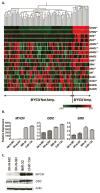
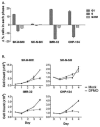
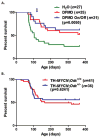
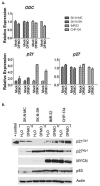
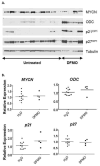
Similar articles
-
DFMO/eflornithine inhibits migration and invasion downstream of MYCN and involves p27Kip1 activity in neuroblastoma.Int J Oncol. 2013 Apr;42(4):1219-28. doi: 10.3892/ijo.2013.1835. Epub 2013 Feb 21. Int J Oncol. 2013. PMID: 23440295 Free PMC article.
-
ODC1 is a critical determinant of MYCN oncogenesis and a therapeutic target in neuroblastoma.Cancer Res. 2008 Dec 1;68(23):9735-45. doi: 10.1158/0008-5472.CAN-07-6866. Cancer Res. 2008. PMID: 19047152 Free PMC article.
-
Key role for p27Kip1, retinoblastoma protein Rb, and MYCN in polyamine inhibitor-induced G1 cell cycle arrest in MYCN-amplified human neuroblastoma cells.Oncogene. 2005 Aug 25;24(36):5606-18. doi: 10.1038/sj.onc.1208808. Oncogene. 2005. PMID: 16007177
-
The MYCN oncoprotein as a drug development target.Cancer Lett. 2003 Jul 18;197(1-2):125-30. doi: 10.1016/s0304-3835(03)00096-x. Cancer Lett. 2003. PMID: 12880971 Review.
-
Polyamine synthesis as a target of MYC oncogenes.J Biol Chem. 2018 Nov 30;293(48):18757-18769. doi: 10.1074/jbc.TM118.003336. Epub 2018 Nov 7. J Biol Chem. 2018. PMID: 30404920 Free PMC article. Review.
Cited by
-
Introduction to the Thematic Minireview Series: Sixty plus years of polyamine research.J Biol Chem. 2018 Nov 30;293(48):18681-18692. doi: 10.1074/jbc.TM118.006291. Epub 2018 Oct 30. J Biol Chem. 2018. PMID: 30377254 Free PMC article. Review.
-
Targeting Oncogenic Transcriptional Networks in Neuroblastoma: From N-Myc to Epigenetic Drugs.Int J Mol Sci. 2021 Nov 28;22(23):12883. doi: 10.3390/ijms222312883. Int J Mol Sci. 2021. PMID: 34884690 Free PMC article. Review.
-
Therapeutic targets for neuroblastomas.Expert Opin Ther Targets. 2014 Mar;18(3):277-92. doi: 10.1517/14728222.2014.867946. Epub 2014 Jan 6. Expert Opin Ther Targets. 2014. PMID: 24387342 Free PMC article. Review.
-
Turning liabilities into opportunities: Off-target based drug repurposing in cancer.Semin Cancer Biol. 2021 Jan;68:209-229. doi: 10.1016/j.semcancer.2020.02.003. Epub 2020 Feb 7. Semin Cancer Biol. 2021. PMID: 32044472 Free PMC article. Review.
-
DFMO/eflornithine inhibits migration and invasion downstream of MYCN and involves p27Kip1 activity in neuroblastoma.Int J Oncol. 2013 Apr;42(4):1219-28. doi: 10.3892/ijo.2013.1835. Epub 2013 Feb 21. Int J Oncol. 2013. PMID: 23440295 Free PMC article.
References
-
- Ries LAG, S M, Gurney JG, Linet M, Tamra T, Young JL, Bunin GR, editors. Cancer Incidence and Survival among Children and Adolescents: United States SEER Program, 1975-1995. National Cancer Institute, SEER Program; 1999.
-
- De Bernardi B, Nicolas B, Boni L, et al. Disseminated neuroblastoma in children older than one year at diagnosis: comparable results with three consecutive high-dose protocols adopted by the Italian Co-Operative Group for Neuroblastoma. J Clin Oncol. 2003;21:1592–601. - PubMed
-
- Seeger RC, Brodeur GM, Sather H, et al. Association of multiple copies of the N-myc oncogene with rapid progression of neuroblastomas. The N Engl J Med. 1985;313:1111–6. - PubMed
-
- Brodeur GM, Seeger RC, Schwab M, Varmus HE, Bishop JM. Amplification of N-myc in untreated human neuroblastomas correlates with advanced disease stage. Science. 1984;224:1121–4. - PubMed
-
- Lee LA, Dang CV. Myc target transcriptomes. Curr Top Microbiol Immunol. 2006;302:145–67. - PubMed
Publication types
MeSH terms
Substances
Grants and funding
LinkOut - more resources
Full Text Sources
Other Literature Sources
Medical
Molecular Biology Databases
Research Materials
Miscellaneous

